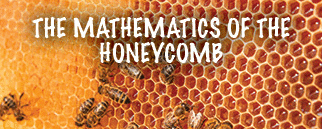

Honeybees are master engineers of the storing of dense fluids. Their fluid is honey, and they store it in an amazing way. Worker bees gorge on honey and excrete slivers of wax. Other workers take that wax and position and mold it into columns of six-sided cells. The bees cluster to keep the temperature of the wax at 35 degrees C (95 degrees F) so that it is firm but malleable. Each wax partition is less than .1 mm thick with a tolerance of .002 mm. The cell walls must be at a 120-degree angle in relation to each other to make a lattice of regular hexagons.
There are only three regular polygons which pack together snugly without leaving gaps — equilateral triangles, squares, and regular hexagons. The perimeter of a hexagonal cell that encloses an area is less than that of a square or a triangular cell, making it the most economical shape. Mathematicians have tried other options, such as using curved sides or a mixture of polygons. They have confirmed that curved polygons could not do as well as straight line hexagons. The cells are tilted upward at an angle of 13 degrees from the horizontal. That is exactly the angle needed to stop the honey from dripping out. There is one more problem. How can the bees seal off the bottom of the columns? They construct the bottom with three, four-sided diamond shapes that meet in a point. Two rows of cells are placed back-to-back and offset, so they interlock. With the cells backing each other up, only one layer of wax serves as the bottom of both cells.
It is difficult to believe that structures such as these are accidents or the final product of trial and error. Mistakes are usually lethal or at least result in a loss of vital energy resources. We think the honeybee engineers learned the principles of structural design from their Creator who is the Master Engineer.
Picture credits:
© kostik2photo. Image from BigStockPhoto.com
